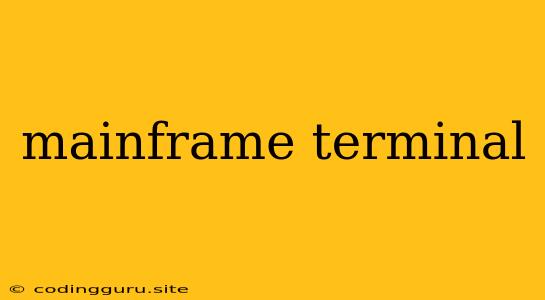What is a Mainframe Terminal?
A mainframe terminal is a device that allows users to interact with a mainframe computer. It's essentially a specialized computer designed to communicate with and receive data from a large central computer, known as a mainframe. Mainframe terminals have been a staple in the world of large-scale computing for decades, playing a crucial role in various industries.
Why are Mainframe Terminals Still Relevant?
While the world has moved towards personal computers and cloud-based solutions, mainframe terminals still hold relevance in several scenarios.
Here's why:
- Legacy Systems: Many businesses still rely on mainframe systems that manage critical operations. These systems are often built on decades-old technologies, and mainframe terminals are often the only way to interact with them.
- Data Security and Reliability: Mainframes are known for their robust security and high levels of reliability. They are ideal for handling sensitive data and mission-critical applications.
- Large-Scale Processing Power: Mainframes excel at handling massive amounts of data and complex computations. They remain essential for industries like finance, retail, and healthcare where high performance is crucial.
Types of Mainframe Terminals
Mainframe terminals have evolved over the years, with different types offering varying functionalities:
- Dumb Terminals: These terminals are the simplest, only capable of displaying data and sending user input back to the mainframe. They lack any processing power or local storage.
- Intelligent Terminals: These terminals have some processing capabilities and memory. They can perform basic tasks locally, reducing the workload on the mainframe.
- Graphical Terminals: These terminals offer a graphical interface, enabling users to interact with the mainframe using menus and graphical elements.
- Emulation Software: Modern alternatives to physical terminals, these software solutions allow users to connect to mainframes from personal computers or mobile devices.
How to Use a Mainframe Terminal
Using a mainframe terminal requires familiarity with specific commands and protocols. Here's a general overview:
- Connect: The terminal is physically connected to the mainframe via a cable or network connection.
- Log In: Users typically log in using a unique username and password.
- Access Applications: Once logged in, users can access various applications and data stored on the mainframe.
- Interact with the System: The terminal provides a user interface for interacting with the mainframe through commands and menus.
The Future of Mainframe Terminals
Although mainframe terminals have been a mainstay for decades, their future is uncertain. Modern technology is constantly evolving, and cloud-based solutions are increasingly popular. However, mainframe systems are unlikely to disappear completely.
Many companies are actively modernizing their mainframe environments, utilizing new technologies like cloud computing and virtualization. As these systems evolve, the need for traditional physical terminals may decline.
Software-based terminal emulators are becoming increasingly popular, offering a convenient way to interact with mainframes from a variety of devices.
Conclusion
Mainframe terminals have played a critical role in the development of large-scale computing, and they continue to be relevant in various industries. While the future of physical terminals remains uncertain, the power and reliability of mainframe systems ensure their continued presence in the technological landscape.
